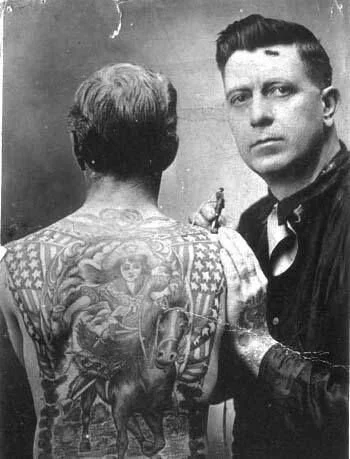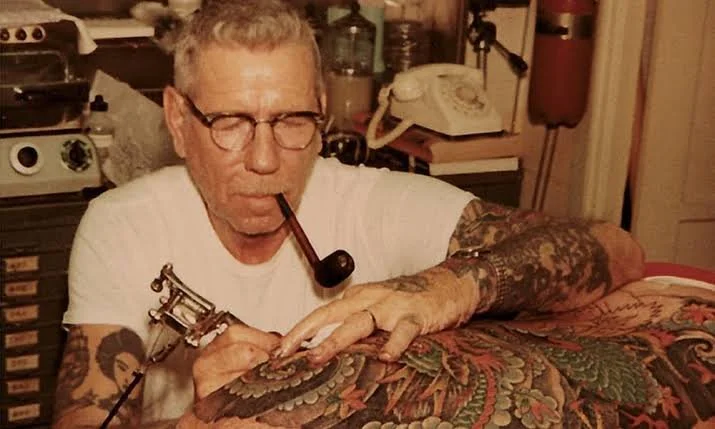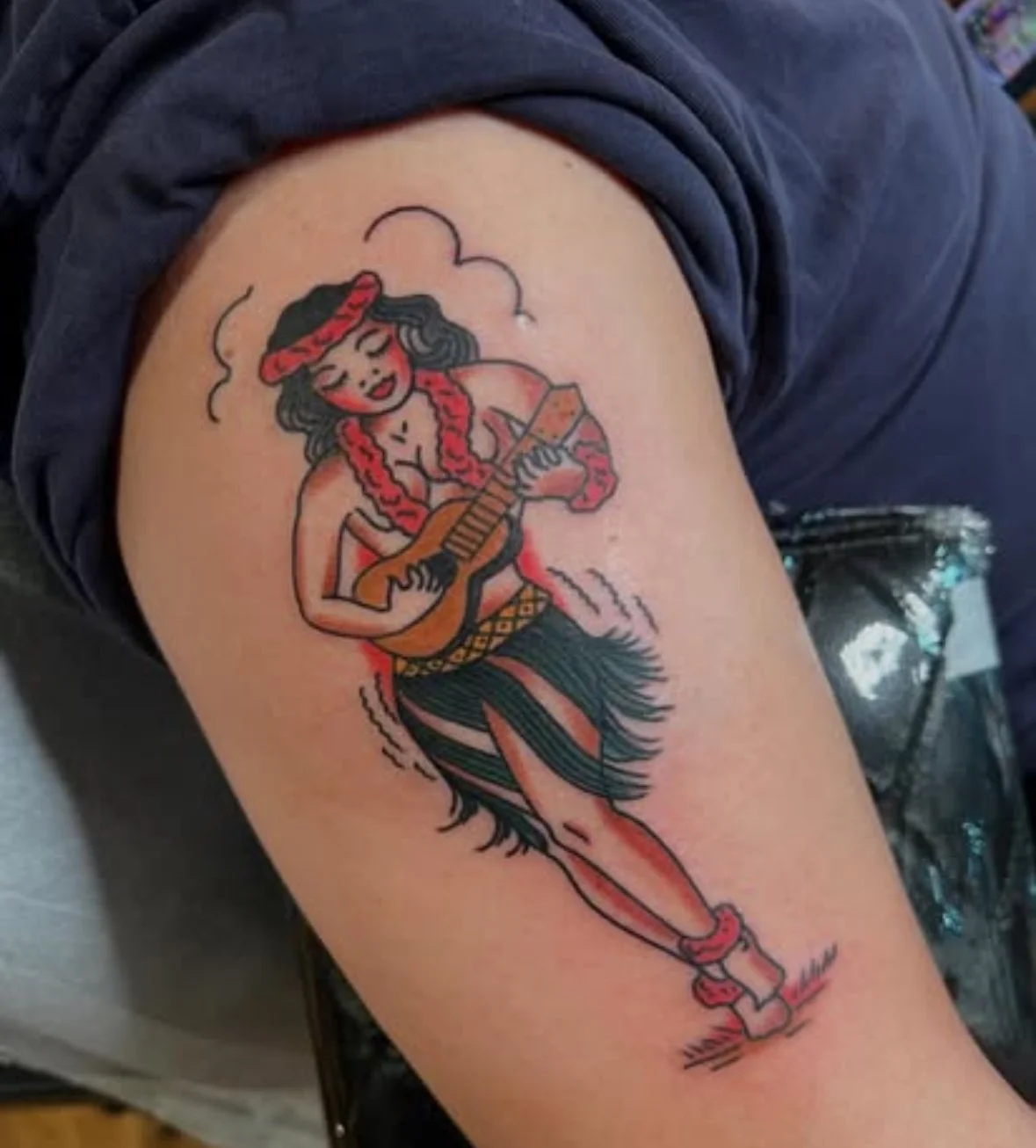History and Legacy of Flash Tattooing
The History and Legacy of Flash Tattooing
Flash tattooing has long been a cornerstone of tattoo history, serving as both a creative showcase and a practical tool for tattoo artists. Rooted in the early 19th century, flash tattoos helped transform the art from a disreputable practice into a more accepted part of working-class culture. Today, flash continues to thrive in modern tattoo shops and remains deeply embedded in tattoo culture.
Bert Grimm Tiger Head tattooed by Casey Sullivan at Rose Tattoo in San Diego
What Is a Flash Tattoo?
A flash tattoo refers to a pre-drawn design, often painted or printed on sheets displayed in tattoo parlors. These designs give clients a quick and easy way to select a tattoo while allowing artists to highlight their individual style. Flash designs can range from small, simple tattoos to more elaborate themed sheets, such as Halloween tattoo flash or the classic Friday the 13th Flash Day.
The term “flash” is believed to come from the idea that designs were meant to be selected and applied quickly—ideal for walk-in clients and high-volume tattoo shops. The designs were meant to be flashy and draw the people in when they saw the designs in a book or on the walls. The term reflected the speed and spontaneity on these ready-to-go designs.
With all things tattooing, everything is steeped in mystery and lore. Some believe the term “Flash” came from the circus where artists would rely on the paintings on the side of circus trains. While referencing the paintings of animals on the side of train cars as they would flash by. Some even say the name came from early tattoo artists working out of bars or barbershops, where artists would string rope through metal grommets on their design sheets and hang from the walls. Since tattooing was illegal at the time, if the artist needed to pack up and leave “in a flash” if the authorities arrived, they could yank the sheets from the walls using the string and carry their tattoo sheets out with them quickly.
Origins of Flash in American Tattoo History
The evolution of flash tattooing is inseparable from the broader history of tattooing in America. In the early 1900s, cities like New York, San Francisco, Chicago, and Los Angeles became major hubs for tattoo culture. These urban centers and Port Cities, often filled with sailors, soldiers, and laborers, embraced tattoos as symbols of identity, belonging, and rebellion. Figures like Bert Grimm, George Burchett, Christian Warlich, Lew Alberts, Tommy Romano, Percy Waters, and Bob Wicks were among some of the first artists who began producing bright and bold sheets of “flash designs”
The Pioneers of Flash Tattooing
• Lew Alberts (aka Lew the Jew) in New York and later Chicago
• Percy Waters in Detroit
• Bob Wicks on the West Coast
• Charlie Wagner, one of Samuel O’Reilly’s apprentices, who helped spread the use of the first electric tattooing machine in New York 1891
George Burchett known also as the “King of Tattooists”
Ben Corday know for being a prolific tattoo flash artist and a progenitor of modern tattooing
Christian Warlich of Germany who is credited as the first artists to use an electric tattooing machine in Germany
Bert Grimm known as the “Grandfather of old-school” and was said to have tattooed the infamous Bonnie and Clyde as well as Pretty Boy Floyd
Samuel O’Reilly, the inventor of the first electric tattoo machine in 1891, laid the technical groundwork for modern tattooing, but these pioneers created bold, eye-catching tattoo designs on paper sheets to attract customers. Their flash often featured motifs like eagles, skulls, hearts, daggers, anchors, ships, and snakes—many of which are still found in modern traditional tattoo flash.
Photo of tattooer Ben Corday
Sailor Jerry and the Golden Era of Flash
No history of flash tattooing would be complete without mentioning Norman “Sailor Jerry” Collins. Working out of Honolulu in the mid-20th century, Sailor Jerry became a legendary figure in American tattoo culture. His tattoo flash sheets featured bold linework, vibrant colors, and timeless imagery—hula girls, swallows, nautical stars, and pin-up girls.
Sailor Jerry’s style helped define the American traditional tattoo aesthetic that remains popular today. His work blended Western motifs with influences from Japanese tattooing, which he deeply admired and studied during his time in the Navy. Sailor Jerry’s influence on tattoo flash design is immense, and many of his iconic images are still reproduced or reinterpreted by tattoo artists today. Other icons like Ed Hardy and Brooklyn Joe Lieberman would follow in his path creating their own unique style of tattooing that blended the Japanese style of artwork with American traditionalism
Norman “Sailor Jerry” Collins Tattooing
Flash Trading and Tattoo Supply Companies
Before the digital age, tattoo artists would share flash art by mailing hand-painted sheets or trading them at conventions. This exchange allowed artists to learn from one another, replicate popular designs, and refine their techniques. It also helped unify and spread stylistic trends across different parts of the country.
In the 1950s and 1960s, companies like Spaulding & Rogers began to mass-produce tattoo machines, needles, inks, and flash sheets. These tattoo supply companies offered professionally printed flash that artists could customize with their own colors and styles. For many shops, these sheets were crucial—they displayed hundreds of options on the walls, allowing clients to pick a tattoo “on the spot.”
Tattoo Flash in the Modern Era
The 1980s and 1990s there was a shift in tattoo culture toward more custom tattooing. With tattooing gaining broader artistic recognition, more clients began seeking original, one-of-a-kind tattoos tailored to their personal stories or symbolism. Ed Hardy would be largely credited for being on of the first artists to offer custom tattoos with the opening of Realistic Tattoo in June 1974. Realistic changed the idea of tattooing by going against all norms. Hardy insisted the shop to be just as discreet and underground as the illegal shops in Japan as well as offering fully customizable designs. The shop was strictly by appointment only with no of the typically neon TATTOO signs often found on the classic walk-in shops. Their slogan, “Wear your dreams”
This rise in custom work didn’t spell the end of flash, however. Instead, flash evolved. Artists began creating hand-painted flash sheets that reflected their personal style rather than mass-produced templates. These unique flash pieces gave clients inspiration and a starting point while preserving the tradition of browsing a tattoo wall for ideas.
Thanks to the internet, artists now share and sell digital tattoo flash designs globally. While social media has become a major platform for discovering tattoo artists, many shops still feature traditional flash designs, blending old-school roots with modern creativity.
Classic American Traditional Pin Up by Gary Dunn of a Sailor Jerry Design done at Rose Tattoo here in San Diego
Classic Tattoo Flash Motifs and Their Meaning
Some of the most enduring flash tattoo designs have deep historical and symbolic roots. Whether you’re into modern interpreted tattoo flash or prefer the vintage classic look of Sailor Jerry tattoo flash, these images have stood the test of time:
• Eagle – Symbol of freedom and patriotism
• Dagger – Represents bravery, danger, or betrayal
• Skull – A memento mori, symbolizing death and resilience
• Anchor – Represents stability and ties to maritime life
• Heart with Banner – Often featuring names or slogans, symbolizing love or remembrance
• Swallow – A sailor’s talisman for safe return, and a nod to travel and loyalty
• Snake and Dagger – A symbol of danger, protection, and cunning
These motifs continue to appear in tattoo flash today, sometimes reimagined with a modern twist or cultural variation.
Flash as a Living Archive
Tattoo flash isn’t just about shop wall decoration or convenience—it’s a living archive of tattoo culture. Flash reflects the values, aesthetics, and social climate of different eras. From the militaristic designs of World War II to the modern designs of the 1990s and beyond, flash captures the evolving spirit of identity through ink.
Collectors and historians now preserve original flash sheets from famous tattoo artists like Ed Hardy, Bert Grimm, George Burchett, and Owen Jensen. These works are considered fine art by many, with some tattoo flash even housed in museums or private collections.
From the walls of early 20th-century tattoo parlors to today’s digital tattoo portfolios, flash tattoos remain a foundational part of tattoo history. They’ve shaped the look of American traditional tattooing, helped popularize timeless motifs, and provided a bridge between tradition and innovation.
Whether you’re a tattoo artist building your own flash library, a client browsing designs at a local shop, or a fan of classic tattoo flash, one thing is clear: flash isn’t going anywhere. It continues to be a vibrant, essential part of tattooing—connecting generations through bold lines, iconic imagery, and shared creativity.



